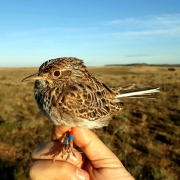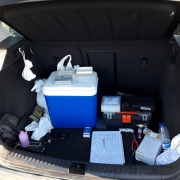The LIFE Ricotí Project marks with metal rings almost 200 individuals of Dupont´s Lark for monitoring in 2017
The LIFE Ricotí Project marks with metal rings almost 200 individuals of Dupont´s Lark for monitoring in 2017
During the spring of 2017 (April-June) and the end of September, the LIFE Ricotí Project (LIFE15 NAT/ES/000802) carried out an intensive work of capture and marking of Dupont´s Lark in the South of Soria province; specifically in the Special Protection Areas for Birds (SPAs) of “Altos de Barahona” and “Páramo de Layna”. These SPAs are among the most important population areas for this species in Spain, which means in Europe.
Capture and ringing activities are addressed to the evaluation of basic biological parameters, such as weight, body condition or level of parasitism infection. Moreover, samples were also focused on further genetic and diet analysis, as well as on studying behavioral characteristics. With all this data, aspects related to body condition, habitat preferences, trophic ecology, dispersal, population structure, among others, are to be assessed.
None individual suffered any damage while being handled. A specialized trained team, with all the respective licenses, was in charge of handling the individuals following all the regulations and recommendations for capturing and handling birds: This allowed to reduce as much as possible any stress situation for the birds. After measuring and getting all the necessary data, birds were released at the same location where they were captured.


During 2017, 199 individuals were captured, from which 172 were males, 11 females and 16 chicks. The results show a clear male bias sampling, which will have to be corrected in future years. The low number of chicks is due to the difficulty of finding this species nests.
During 2018, the LIFE Ricotí Project will continue working on census and captures at the same study areas in the South of Soria. The purpose is to monitor not only these populations, but also the effect that the different habitat management measures, established by the LIFE Ricoti Project, have on the Dupont´s lark habitat use. Furthermore, in order to complete the genetic and diet analysis, at a bigger spatial scale, census and captures of individuals will be carried out in the surrounding areas of the Iberian System (i.e Segovia, Cuenca, South of Teruel) and at National scale (Zamora, Almería, Murcia, etc.). Thus, the population structure and viability of this species could be determined in a wider scale.
Daniel Bustillo and TEG Ricotí-UAM team
Copyright © 2020 - Aviso Legal | Acceso | Desarrollado por Cesefor





